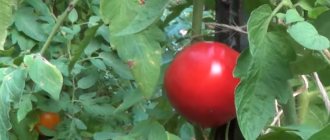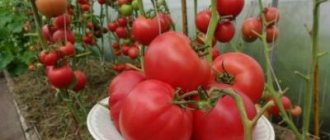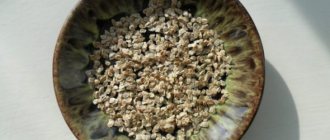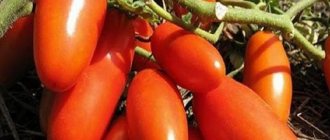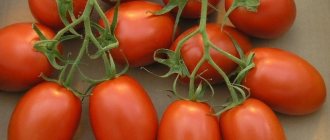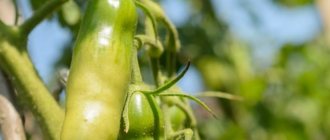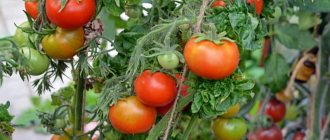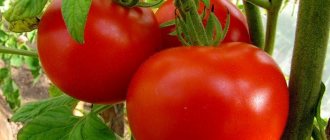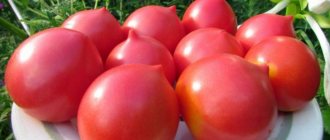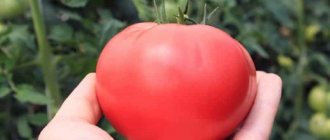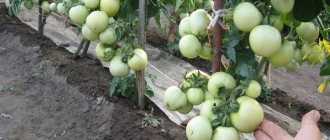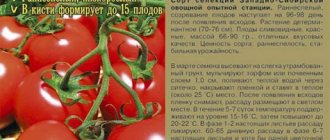Tomato Temptation: characteristics and description of the variety
This is an early ripening hybrid with pepper-shaped fruits. The culture belongs to the category of indeterminate, so its height is not limited: from average height to several meters in height. Resistant to many diseases and pests, in particular to tomato mosaic virus, fusarium, nematode.
The first inflorescence is formed above the 7-8 leaf, and 7 fruits ripen in the cluster. Both fresh and canned tomatoes are eaten. The hybrid is considered the most productive among other tomato varieties: up to 20 kg of fruits are harvested from 1 sq. m. But this is not the limit: knowledge of agricultural technology will increase the amount of harvest. Ripening occurs in 100-105 days.
This vegetable crop is distinguished by its taste and commercial qualities. It also has good transportability.
Taste qualities of tomatoes Royal temptation from the company Partner
Tomatoes have the following characteristics:
- the fruit is bright red, has a cylindrical shape, lengthening towards the end;
- The skin of tomatoes is smooth, dense, and can sometimes crack;
- inside the tomato there are from two to three seed chambers, which makes the berries ideal for salads and snacks;
- average fruit weight - 120 g;
- tomatoes are juicy and have great taste;
- they have an excellent presentation;
- tomatoes of this variety can be easily transported even over long distances.
The fruits have practically no characteristic tomato sourness; their pulp is sugary and sweet. They look great in homemade preparations, assorted dishes. In addition, tomatoes can be dried, dried and frozen.
How to grow seedlings
Growing seedlings is an important stage in the life of any plant. At this time, its health and ability to bear fruit are established. Therefore, it is so important to sow the seeds correctly and create favorable conditions for the plant.
Preparation
To obtain high-quality seedlings, seeds are treated with a 1% solution of potassium permanganate by immersing them in a glass jar for 20 minutes. After this, they are thoroughly washed and dried.
To stimulate growth, it is recommended to treat seeds with a product such as Immunocytophyte. After processing, the seeds are dried.
Important! There is no need to wash the seeds after using growth stimulants.
Container and soil
Seedlings are grown in wooden boxes or peat pots, and the latter are convenient because when planting in the soil there is no need to free the root system - they are planted in the ground directly in the pot. Plastic cups are also convenient for this purpose: before planting, they are carefully cut, the earthen lump remains unharmed. Wooden boxes are the cheapest to use, but it is worth remembering that in this case the process of planting seedlings will require a little more work and patience.
The soil mixture is prepared as follows: 2 parts of peat are mixed with 1 part of soil (from the garden), 1 part of sand and 0.5 part of humus. The resulting mixture is disinfected 10 days before use.
Sowing
In separate containers filled with prepared soil, 2-3 seeds are sown at a distance of at least 2 cm from each other.
When sowing in boxes, grooves of 4 cm are made, where seeds are placed at the same distance as in containers.
Seedlings of early hybrids are planted in the greenhouse in the second decade of April. Therefore, seeds are sown in early March. Shoots appear within a week after sowing. The plant blooms 55-60 days after planting the seeds.
Growing and care
During the first week, containers sown with seeds are covered with film at a room temperature of at least 25 ºС. At the first shoots, the film is removed and the temperature drops to 18 ºС. The containers are placed on the window to eliminate the lack of sunlight. Fluorescent lamps are suitable for additional lighting, since the daylight hours for seedlings should be at least 12 hours.
At first, the soil is not watered; spraying with a spray bottle is sufficient. For this purpose, boiled or settled water is used, with a temperature of at least 20 ºС.
After full-fledged leaves appear, watering begins at the root. 10 days after this, light fertilizing is added to the watering using complex fertilizers with a high nitrogen content. This fertilizer is prepared from potassium salt (1.5 g), urea (0.5 g), superphosphate (4 g), dissolved in 1 liter of water. Watering should be done twice a week.
Disease and pest control
Since the tomato Royal Temptation F1 is immune to many diseases, it will only require a little preventive maintenance. It is carried out by spraying before flowering and during fruit ripening. The best means for this would be a solution of potassium permanganate and Bordeaux mixture.
To spray with potassium permanganate, you need to prepare a weak solution. For 1 liter of water you will need 2-3 crystals of the substance. Spraying with this product is carried out 2 times during the spring season and 1 time 2 weeks before harvest.
Bordeaux mixture is used at the same time as the potassium permanganate solution. To further protect the plant, it is recommended to alternate the use of these products.
TOMATO ROYAL TEMPTATION F1 the name speaks for itself
THE BEST TOMATO FOR STUFFING! ROYAL TEMPTATION F1
Review of agro tomato hybrids
How to grow tomatoes
To grow the Tsarskoe Temptation variety, the seedlings must be hardened off. A week after germination, the temperature is regularly reduced: during the day to 18ºC, and at night to 13ºC. In addition, hardening is performed by ventilating the room.
Landing
Planting seedlings in open ground occurs at a soil temperature of at least 15 ºС and an air temperature of at least 20 ºС.
Seedlings are planted in the greenhouse from mid-April, but the final date is determined by the appearance of the plant: height - at least 20 cm, number of leaves - at least 7, thickness - at least 5 cm.
Care
Taking care of this vegetable crop is a guarantee of qualitative and quantitative results. This variety, despite its royal name, is unpretentious to weather conditions and care during growth and development. But nevertheless, the plant will not be able to grow on its own without outside help.
Watering
First of all, the frequency of watering depends on precipitation. In the absence of rain, the plant is watered once a week, fed every 2 weeks with a mixture whose composition is as follows: ammonium nitrate (15 g), superphosphate (50 g), potassium chloride (40 g) per 10 liters of water. It is also recommended to feed with magnesium once every 2 weeks, and when the first flowers appear, add boron.
Stepsoning
Produced to increase the yield of the bush. In the southern regions, 2 shoots are left - the ovary will have time to ripen during a long warm period. In the northern ones, only one, central, shoot is left. Otherwise, the first frosts will occur before ripening.
The pinching procedure is carried out in the morning.
Important! It is impossible to plant crops in damp and cool weather, as infection can enter the plant through wounds.
Tomato bushes need regular weeding and loosening. Loosen the soil after each watering. To keep moisture in the soil longer, it is mulched. Straw or sawdust is used as mulch.
A garter is also necessary, otherwise, under the weight of its own fruits, it will completely lie on the ground. Usually, a support (for example, a wooden stake) is installed next to the bush, to which the top of the plant is tied.
For preventive treatment, systemic-contact fungicides are used: Ditan M-45, Quadris 250. Vegetable crops are sprayed once every 20 days.
Growing
Compliance with certain rules will allow the gardener to harvest up to 25 kg of tomatoes from one bush. Plants need to be provided with timely watering, warmth, light, protection from diseases, pests and weeds. It is also important to tie up the stems and, if necessary, fruit clusters in a timely manner.
Growing seedlings
Seedlings of the Tsar's temptation variety can be grown in wooden or plastic boxes, in peat pots, and even in ordinary disposable glasses. Experts advise using peat cups so that replanting the plant in the ground is stress-free for the bush. Peat cups are directly dug into the soil, after which they decompose and serve as additional fertilizer.
Tomato seedlings Royal Temptation are planted in a heated greenhouse, where the temperature during the day is more than 15 ° C. In central Russia, planting begins in April, in the southern regions - in the first half of March. Tomatoes are planted in open ground in the middle zone at the end of May - beginning of June, in the south of the country - at an earlier date. In conditions of a significant decrease in temperature, seedlings are provided with additional film protection on the arches or a special covering material is used.
In order to get a good soil mixture for planting tomatoes for seedlings, you need to mix two parts peat, part soil and half part sand. Before sowing, the resulting composition is sifted and disinfected using a double boiler or oven. Parasites and pathogenic bacteria die under the influence of high temperatures. Disinfection is carried out approximately ten days before sowing.
The seedlings are placed in a warm place under the film, and they do not need additional lighting.
The first shoots appear on the 3rd – 10th day after planting. From this point on, the temperature is reduced to 7 °C, and the illumination is increased to the maximum. This is necessary for the proper formation of the root system.
And in a common container, seedlings are picked into separate containers after the appearance of 2 true leaves.
Important! After picking, to prevent the plants from stretching and weakening, they are provided with good light and moderate temperature.
Landing rules
Plants are planted in a row; there should be a distance of at least 50 cm between the bushes, while per 1 sq. m. place no more than 3 - 4 bushes. This allows tomatoes to grow in the most comfortable conditions without interfering with other bushes.
Advice! To prevent blossom end rot, any calcium-containing fertilizer should be added to the soil.
Watering and fertilizing
Tomatoes Royal Temptation do not tolerate drought; stable daily watering will bring 80% of a good harvest. But you cannot flood the bushes: the roots and stems may begin to rot, and the fruits will become excessively watery. To maintain a sufficient level of moisture at the roots, you can mulch the bed with sawdust or straw in a layer of up to 3 cm.
Feeding and fertilizers are applied during flowering and fruit formation, as well as after planting seedlings.
Gardeners use:
- Complex fertilizers.
- A solution of boric acid (at the rate of 10 g per 10 liters of water) and calcium nitrate - during the period of flowering and ovary formation. Saltpeter protects tomatoes from blossom end rot.
- When watering, you can add a solution of ash to the water.
Pinching and tying
Stepchildren are additional shoots growing in the axils of the leaves. If you do not remove them in time, the plant thickens. The bush grows, mineral nutrition is spent on the development of additional shoots and leaves. Pruning is necessary to increase crop productivity.
Formation
Video advice on how to properly plant tomatoes:
Growing the Royal Temptation tomato is carried out in 2 stems in greenhouses and southern latitude. In the northern regions, it is better to leave one stem per bush.
Indeterminate varieties require staking of bushes, since the elongated plant will be forced to bend over by ripening heavy fruits. To avoid breaking, the stem is tied to a post with a soft rope or garden wire (coating it with pile will prevent injury to the delicate stem of the bush).
Advice! For gartering tomatoes, you can use regular sheets. Old bed linen is cut into long strips and tied to bushes.
Protection from diseases and pests
To protect against parasites and diseases, the Royal Temptation tomato needs to be sprayed. The most popular drugs:
- Fundazol. An effective remedy for gray rot and other diseases.
- Switch. A means of protection against diseases and harmful insects.
- Bravo 500. The chemical composition of this product can rid tomatoes of bacteria that cause frequent plant diseases.
In addition to the above drugs, you can use Ditan m45, Infinito 61, Quadris 259.
Advantages and disadvantages of the variety
Like any other crop, the Royal Temptation f1 tomatoes have both advantages and disadvantages. Benefits include:
- early and rapid ripening;
- fruit fleshiness;
- resistance of the variety to major diseases;
- high productivity;
- excellent taste and presentation.
Several disadvantages of this royal species:
- requires a garter;
- overripe fruits crack;
- does not differ in productivity in the north of the country;
- Growing in the shade leads to a deterioration in taste characteristics.
Description of tomato variety Tsarskoe temptation with photo
The Tsar’s Temptation tomato is a first generation hybrid (F1), bred in Russia several years ago (breeding work was carried out by N.P. Fursov, agro). In 2021, this variety was included in the register of selection achievements. It is noted that bushes can be grown in most regions of Russia - both in greenhouses and in open beds.
Main characteristics of the tomato Royal Temptation F1:
- indeterminate (grows throughout the season);
- tall (1.5-2 m);
- mid-season (100-110 days).
Bush of medium foliage. The leaves are moderate in size, rich green in color, and have a typical shape. The internodes are short (compared to most other varieties). The inflorescences are of a simple type, the first of them appears above the 7th or 8th leaf, then they are laid after 1-2. In a heated greenhouse, up to 20 flower clusters are formed per season. Each of them bears up to 8-10 fruits. The peduncle has an articulation.
Important! Tomatoes "Tsar's Temptation" can bear fruit all year round. The bushes grow up to 5 m in height if appropriate conditions are created for them (growing in a heated and illuminated greenhouse).
Description of fruits
Tomatoes Tsar's Temptation are distinguished by their characteristic elongated shape; in appearance they resemble bell peppers. A sharp point is visible at the bottom. Unripe tomatoes are light green, yellowish in color. They then turn orange, and ripe fruits take on the classic bright red color.
The skin is smooth and dense, without wrinkles or ribbing. The fruits are small in size - up to 8-10 cm in length and 4-5 cm in width. At the same time, the average weight is 120 g. The pulp is juicy and tender, the taste is sweet, pleasant, without even a slight sourness.
Tomatoes "Tsar's temptation" have time to ripen on the bush
Farmer reviews
There are so many favorable reviews from farmers that all doubts about choosing a tomato variety disappear. Even those who grew this species for the first time are delighted. They are especially noted for their disease resistance and excellent taste. Many of the farmers touchingly call this crop “my love.”
Lyudmila, Saratov: “I took the seeds of the Royal Temptation from a neighbor. I don’t really like newfangled hybrids, but this time I decided to make an exception. And I was not mistaken! I and the whole family liked the large, moderately sweet tomatoes. No special care is required."
Planting seedlings in a permanent place
Seedlings are planted in open ground when the soil has already warmed up sufficiently (up to +15 °C), and the air temperature will remain at +20 °C during the day. If the area where the seedlings are planned to be planted is located in the southern region, the seedlings are planted in mid-May, if in the northern region - at the end of May.
Seedlings are planted in the greenhouse in mid-April.
The time for planting seedlings can be determined based on the external characteristics of the plant: height - 20-25 cm, stem thickness - 5-7 mm, number of leaves - 7-9. Each plant is planted at a distance of at least 60–70 cm from each other, maintaining a gap between rows of about 70–80 cm.
